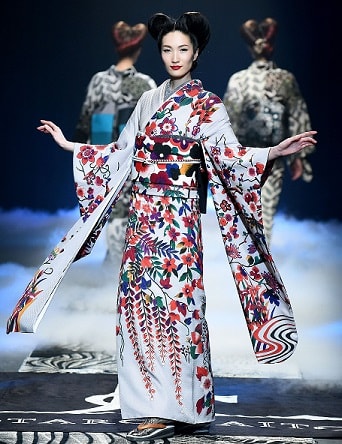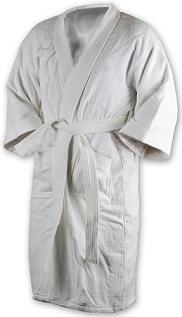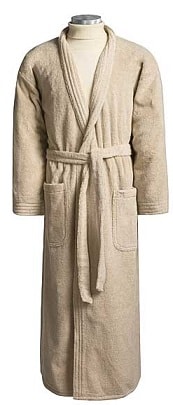
There is a difference between a traditional Kimono and how Kimono is often referenced in the United States. A kimono in the USA may refer to the traditional clothing worn by the Japanese, but it can also reference clothing such as a type of bathrobe. The term is also used for tops & dresses when referring to a kimono sleeve or collar.
Traditional Japanese Kimono Style:
Kimono are T-shaped, straight-lined robes worn so that the hem falls to the ankle (full length robes), with attached collars and long, wide sleeves. This is a traditional Japanese garment and the name literally translates to ‘thing to wear’. The kimono style robe actually has no collar per se. Japanese kimonos are wrapped around the body, sometimes in several layers, and are secured in place by sashes with a wide obi to complete it. There are accessories and ties needed to wear the kimono correctly.

United States Kimono Style:
In the United States kimono can refer to a type of sleeve and a type of collar. Both of which are based on the styling from the traditional Japanese Kimono.
The kimono style robe in the USA primarily refers to a bathrobe which is different than a traditional Japanese Kimono. It only shares in the collar styling. In America you can find terry robes, fleece robes, silk, and bathrobes made in other materials produced in a kimono style.


Kimono sleeve are wide loose short or wrist length. This style is obtained from traditional Japanese dresses and adapted as today fashion. Kimono sleeves are used on shirts, blouses, and dresses. A kimono sleeve can also be used on outerwear.
More about the Japanese Kimono:
Obi which literally means "sash" is for traditional Japanese dress, keikogi (uniforms for Japanese martial arts), and part of kimono outfits.
The obi for men's kimono is rather narrow, 10 centimetres (3.9 in) wide at most, but a woman's formal obi can be 30 centimetres (12 in) wide and more than 4 metres (13 ft) long. Nowadays, a woman's wide and decorative obi does not keep the kimono closed; this is done by different undersashes and ribbons worn underneath the obi. The obi itself often requires the use of stiffeners and ribbons for definition of shape and decoration.
There are many types of obi, most for women: wide obis made of brocade and narrower, simpler obis for everyday wear. The fanciest and most colourful obis are for young unmarried women. The contemporary women's obi is a very conspicuous accessory, sometimes even more so than the kimono robe itself. A fine formal obi might cost more than the rest of the entire outfit. Obis are categorized by their design, formality, material, and use. Informal obis are narrower and shorter.
The Kimono are wrapped around the body, always with the left side over the right (except when dressing the dead for burial) and secured by a sash called an obi, which is tied at the back. Kimono are generally worn with traditional footwear (especially zôri or geta) and split-toe socks (tabi).
The modern kimono is not worn as often as it once was. Most women wear western-style clothing and only wear kimono for special occasions. In modern Japan, kimono are a marked feminine costume and a national attire. There are multiple types and subtypes of kimono that a woman can wear: furisode, uchikake and shiromuku, houmongi, yukata, tomesode, and mofuku, depending on her marital status and the event she attends.
There are types of kimonos that are worn for different occasions and seasons. Women typically wear kimonos when they attend traditional arts, such as a tea ceremonies or ikebana classes. Girls and young single women wear furisode: a colorful style of kimono with long sleeves that are tied with a brightly-colored obi.
During wedding ceremonies, the bride and groom will often go through many costume changes. Shiromuku or uchikake are worn by brides, which are heavily embroidered white kimonos. Grooms wear black kimonos made from habutae silk. For funerals, men and women wear plain black kimonos. (It is acceptable to wear black suits for weddings and funerals.)
The "coming of age" ceremony, Seijin no Hi, is another occasion where kimonos are worn. At these annual celebrations, women wear elaborately colored kimonos, often with boas. Other occasions where kimonos are worn today include New Year, graduation ceremonies, and Shichi-go-san, which is a celebration for children.
Today, kimono are most often worn by women, and on special occasions. Traditionally, unmarried women wore a style of kimono called furisode, with almost floor-length sleeves, on special occasions. A few older women and even fewer men still wear the kimono on a daily basis. Men wear the kimono most often at weddings, tea ceremonies, and other very special or very formal occasions.
Professional sumo wrestlers are often seen in the kimono because they are required to wear traditional Japanese dress whenever appearing in public.
A yukata is a Japanese garment, a casual summer kimono usually made of cotton or synthetic fabric, and unlined. Yukata are worn by men and women. Like other forms of traditional Japanese clothing, yukata are made with straight seams and wide sleeves. Men's yukata are distinguished by the shorter sleeve extension of approximately 10 cm from the armpit seam, compared to the longer 20 cm sleeve extension in women's yukata. A standard yukata ensemble consists of a cotton undergarment (juban), yukata, obi, bare feet, sandals (geta), a foldable or fixed hand fan, and a carry bag (kinchaku). Kinchaku are used by both men and women to carry cellphones and other small personal items. For men, an optional hat may also be worn to protect the head from the sun. Yukata literally means bath(ing) clothes, although their use is not limited to after-bath wear. Yukata are a common sight in Japan during the hot summer months.
Fashion Products Fashion Products G-L Fashion Products K
Return to the Influence
Fashion home page.
Copyright 1999-2023 Apparel Search Company. All Rights Reserved.